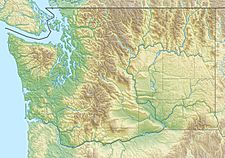Spire Glacier facts for kids
Quick facts for kids Spire Glacier |
|
|---|---|
| Type | Alpine glacier |
| Location | Skagit County, Washington, U.S. |
| Coordinates | 48°19′15″N 121°04′48″W / 48.32083°N 121.08000°W |
| Length | .50 mi (0.80 km) |
| Terminus | Icefall/Barren rock |
| Status | Retreating |
Spire Glacier is a cool natural ice formation found in the Snoqualmie National Forest in the state of Washington, U.S. It sits on the western side of a mountain called Spire Point. This glacier flows generally towards the northwest and is about .50 mi (0.80 km) long.
A sharp, rocky ridge, known as an arête, separates Spire Glacier from another glacier called Dana Glacier to its east. Spire Glacier starts high up, at nearly 7,400 ft (2,300 m), and flows down to about 6,000 ft (1,800 m).
Contents
What is a Glacier?
A glacier is like a giant, slow-moving river of ice. It forms over many, many years when snow falls in one place and doesn't melt completely. Each year, more snow piles up on top of the old snow. The weight of all this new snow presses down on the snow below.
How Glaciers Form and Move
As the snow gets squeezed, it changes into a very dense, hard ice. This process takes a long time. Once enough ice builds up, gravity starts to pull it downhill. Even though ice seems solid, it can actually flow very slowly. This slow movement is what makes a glacier.
Spire Glacier is an "alpine glacier." This means it forms in high mountain areas, often in bowl-shaped hollows or valleys.
Where is Spire Glacier Located?
Spire Glacier is in the North Cascades mountain range. This area is known for its rugged peaks and many glaciers. The glacier is specifically located in Skagit County, Washington.
The Snoqualmie National Forest is a huge protected area. It is full of forests, mountains, and rivers. Spire Glacier is just one of the many natural wonders you can find there.
Why are Glaciers Important?
Glaciers like Spire Glacier are very important for several reasons. They act like giant frozen water tanks. In the summer, when snow melts, glaciers slowly release water. This meltwater feeds rivers and streams. It provides drinking water for people and animals. It also helps with farming and generating electricity.
Glaciers are also like natural thermometers. They can tell us a lot about the Earth's climate. When the climate gets warmer, glaciers tend to shrink. When it gets colder, they might grow.
What Does "Retreating" Mean?
The Infobox mentions that Spire Glacier is "retreating." This means the glacier is getting smaller. It is melting faster than new snow can turn into ice and add to it. When a glacier retreats, its front edge moves back uphill.
Many glaciers around the world are retreating. Scientists study this to understand how our planet's climate is changing. The retreat of glaciers can affect water supplies and ecosystems.


